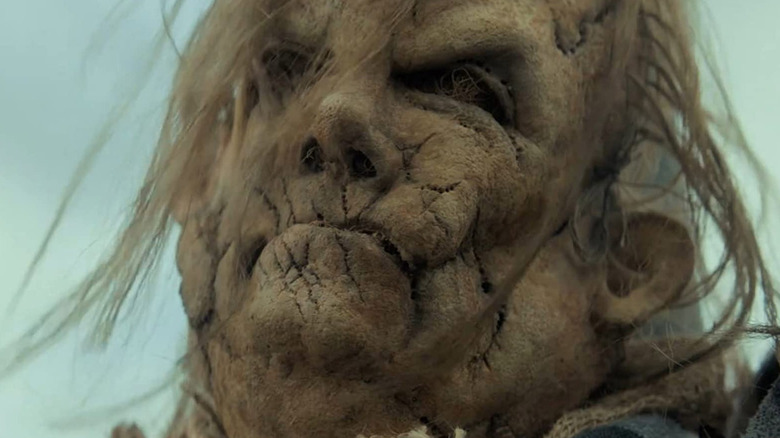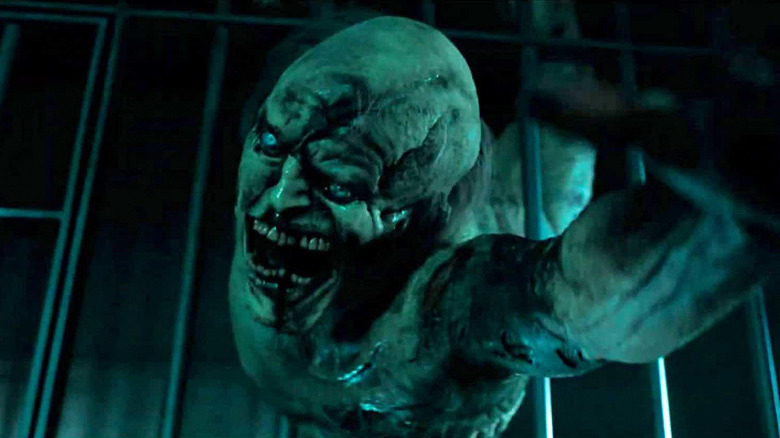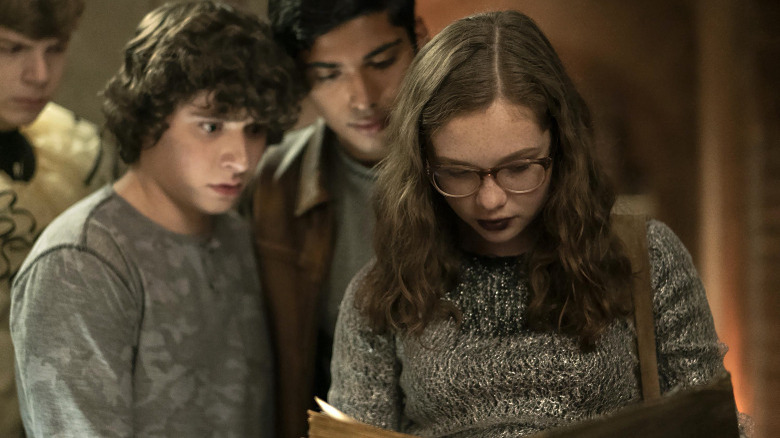How James Cameron And A Real-Life Kidnapping Connect Guillermo Del Toro To Scary Stories To Tell In The Dark
One cannot discuss the legacy of "Scary Stories to Tell in the Dark" without talking about Stephen Gammell. The illustrator's original artwork for writer Alvin Schwartz's short kids' horror stories is evocative, visceral, and often disgusting. His black ink drawings depict horrors like a skull-headed monster with runny eyeballs, a grinning corpse with a veiny neck, and howling specters that evoke Edvard Munch's "The Scream." Perhaps most notorious of all is his sketch for "The Red Spot," which shows baby spiders pouring from the burst pouch on a young girl's face.
Much to the disappointment of weirdo kids who grew up fawning over Gammell's drawings (like yours truly), later editions of the "Scary Stories" collections replaced his work with art from Brett Helquist at the behest of alarmed parents. However, when it came time to bring the books to the big screen, director André Øvredal and co-writer and producer Guillermo del Toro rightly went back to the beginning. Their 2019 film "Scary Stories to Tell in the Dark" recreates many of the most terrifying images conjured up by Gammell, from that of the "Red Spot" to Harold the killer scarecrow and the angry cadaver searching for its missing toe.
For del Toro, this was about more than being faithful to the source material. It was also about honoring a tumultuous event in his actual life.
A real-life scary story
Initially published over a 10-year period starting in 1981, the "Scary Stories to Tell in the Dark" books retell spooky tales from a variety of sources, including folklore collections and first-hand interviews. Speaking at a teaser trailer launch event for the film adaptation in March 2019 (via Variety), Guillermo del Toro revealed that he first stumbled upon the books when he was growing up. "I basically was roaming through a bookstore, in San Antonio, Texas," he said. "I was in my early teens, and I came upon this volume that had an irresistible title: 'Scary Stories to Tell in the Dark.'"
While it was the "creepy" cover art that originally got him reading, del Toro praised Alvin Schwartz's retellings for really pulling him in as a teenager, calling them "incredibly efficient and lean and mean." Jump ahead a decade and del Toro would deliver his own lean, mean mix of fable and horror with his directing debut on the 1993 vampire drama "Cronos." Four years after, tragedy abruptly struck the fledgling filmmaker when his father, Federico del Toro Torres, was kidnapped and held hostage in Mexico. A good friend of Guillermo del Toro's by the name of James Cameron would provide the $1 million ransom. Even so, del Toro was left in dire financial straits by the whole ghastly turn of events.
So, naturally, he did what any of us do when we're broke and stressed out. He got some retail therapy.
The healing power of art
Shortly after his father's kidnapping and rescue, Guillermo del Toro discovered an art gallery that was selling Stephen Gammell's original art for the "Scary Stories to Tell in the Dark" books and elected to buy some. "I was really, really broke but I was extravagant and bought the key illustrations from the book that I love, which led to a lot of financial trouble after that and marital trouble after that," del Toro confessed. He stood firmly by the decision, too. "You cannot justify a buy like that. But I needed to have the key images that affected my youth."
Art, of course, cannot heal all wounds and is never a replacement for honest-to-goodness therapy, but it can be complementary and help us to work through our personal traumas. This is clearly what "Scary Stories to Tell in the Dark" did for del Toro when it made its way back into his life. It's no wonder that he boarded CBS Films' movie adaptation of the book series in 2016, ultimately teaming up with The Hageman Brothers — del Toro's collaborators on the animated franchise "Trollhunters: Tales of Arcadia" — on the script and recruiting director André Øvredal on the heels of his creepy-as-hell 2016 thriller "The Autopsy of Jane Doe."
The movie version of "Scary Stories to Tell in the Dark" is never quite as chilling as the combination of Stephen Gammell's imagery and Alvin Schwartz's writing (really, how could it be?), but it is a spooky good time that doubles as an excellent gateway for younger horror fans. That it also speaks directly to our fears and anxieties in the present only feels right, given the way its source material helped to guide del Toro out of a terrible period in his own life.


